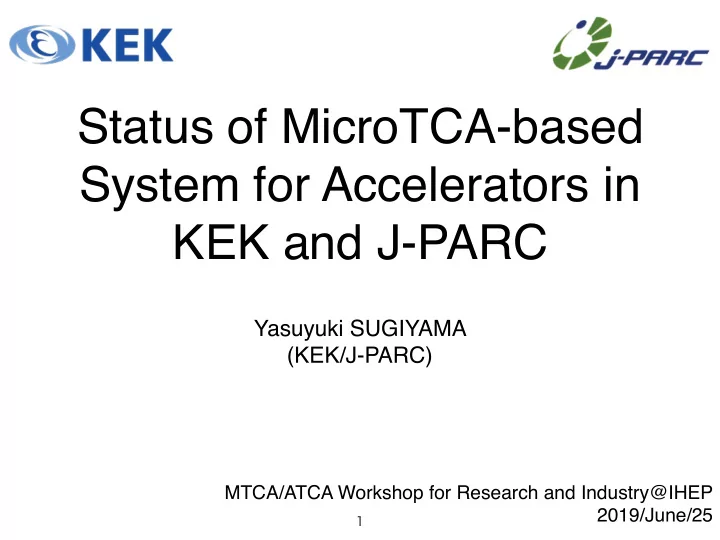

1 Status of MicroTCA-based System for Accelerators in KEK and J-PARC Yasuyuki SUGIYAMA (KEK/J-PARC) MTCA/ATCA Workshop for Research and Industry@IHEP 2019/June/25
KEK 2 National laboratory for High Energy Physics • and accelerator systems. Two campus • KEK(Tsukuba campus): SuperKEKB,PF.. • Tokai campus: J-PARC (inside JAEA) •
3 KEK (Tsukuba) e ± accelerators complex • LINAC: • Injector for synchrotrons SuperKEKB SuperKEKB: e ± collider for • HEP experiment (Belle2) STF PF-AR Photon Factory(PF) • /PF-AR: SR photon source ATF cERL STF: Superconducting RF • Test Facility for ILC Damping Ring ATF: Accelerator Test Facility • for ILC LINAC cERL: Test Facility for a • future 3-GeV Energy Recovery LINAC (ERL)
4 MTCA module used in KEK Module made by Mitsubishi Electric TOKKI systems Co.,Ltd • EPICS-IOC is running on the LINUX installed on the CPU in the FPGA. • In 2008, the development of digital board based on MTCA.0 was started for the aim of • common use at RF control among SuperKEKB, cERL, and STF in KEK. Type1 :used for cav-voltage regulation and cav-tuning • Type2 : used for RF direct (under) sampling method to • monitor the slow (narrow band) phase change. In 2013, the development of the module based on MTCA.4 for the LLRF system of STF • Type3 : SFP on the RTM is used to communicate with other module. • Newly developed board based on MTCA.4 Type2 Type3 FPGA (Virtex 5 FX), • 2 x 14-bit ADCs (Max. 400MSPS) • Type1 Digital I/O • FPGA (Virtex 5 FX), • 2 x SFP • 4 x 16-bit ADCs (Max. 130MSPS) • 2 FPGAs • Mitsubishi Electric TOKKI System Co., Ltd. 1 x RJ-45 • 4 x 16-bit DACs • (Zynq-7000, Spartan 6) Digital I/O • Digital I/O • 14 x 16-bit ADCs • Mitsubishi Electric TOKKI System Co., Ltd. 2 x 16-bit DACs • Mitsubishi Electric TOKKI System Co., Ltd.
5 Present status of KEK Accelerators using MTCAs l SuperKEKB Ring LLRF control system (feedback control) => Newly installed at Damping Ring Reference system (feedback control) Beam Orbit feedback control at Interaction Point l SuperKEKB Linac Reference system (monitor => feedback control) l STF (Superconducting rf Test Facility) LLRF control system (feedback control) Reference system (monitor => feedback control) l cERL (Compact Energy Recovery Linac) LLRF control system (feedback control) 07 Dec. 2017 The 6th MATSUMOTO, Toshihiro (KEK) 5 MicroTCA Workshop
6 SuperKEKB Project Luminosity : KEKB x 40 ! KEKB is being upgraded to SuperKEKB. • The first beam commissioning (Phase-1) was successfully accomplished 2016. • The commissioning with beam collision (Phase-2) began in March of 2018. • The Belle2 physics run (Phase-3) began in March of 2019. • Circumference ~ 3km Beam Current: x 2 Acc. Beam Power : x 3 β y @IP: 1/20 (200kW -> 600kW) Positron damping ring for low emittance injection Low emittance Photocathode electron gun
7 New LLRF control system SuperKEKB with high accuracy and flexibility for superKEKB Block Diagram of Vc-FB & Tuner Control Existing analog LLRF system for KEKB f rf = 508.9GHz replace New LLRF Control System μTCA shelf unit (5 AMCs) Type1 16-bit ADC x 4ch, EPICS-IOC embedded 16-bit DAC x 4ch I/Q-sampling for 10.6-MHz IF Mitsubishi Electric TOKKI System Co., Ltd. • Consisting of μTCA-platformed FPGA boards & PLC. • Type1 board is used for Cav. field FB control , Cavity Tuning and RF- I/L. • EPICS-IOC with Linux-OS embedded in each board. 20 • The regulation stability is 0.02% in amplitude and 0.02 deg. in phase.
8 STF-2 : Prototype of ILC-TDR (2015- ) In STF-2, two digital LLRF boards connected with optical • STF-2: Prototype of ILC-TDR communication are configured for operation. One 10-MW MBK drives 12 SC cavities. → minimal combination of ILC LLRF system . RF conditioning of 8 SC cavities MTCA.4 standard board (Oct. – Nov., 2016 ) 2ch SFP connectors 8 SC cavities were operated with average 30.5 MV/m under vector- sum feedback control. Zynq-7000(XC7Z045): ARM (Cortex-A9) → EPICS-IOC Cavity-field vector-sum in digital board #1 VS1 VS3 Cavity-field vector-sum in digital board #2 ΔA/A =0.006%rms (0.07%@ILC) VS3 VS3 Δφ = 0.03deg.rms (0.35deg.@ILC) 07 Dec. 2017 The 6th MATSUMOTO, Toshihiro (KEK) 39 MicroTCA Workshop
9 J-PARC (Japan Proton Accelerator Research Complex) Joint Project between KEK and JAEA High intensity Proton Accelerator with a LINAC and two synchrotrons. • Started the beam commissioning from 2006 and achieved the high intensity proton delivery. • LINAC : 400MeV negative hydrogen ( H - ) with 40mA (25 Hz) • Rapid Cycle Synchrotron (RCS) : 3 GeV proton with 1 MW (25 Hz). • Main Synchrotron Ring (MR) : 30 GeV proton with 500 kW (2.48 s cycle) for the neutrino • experiment, 51kW(5.52 s cycle) for the Hadron Experiment. Hadron MR(30GeV) J-PARC facility 51kW RCS µ,n Tokai 1MW (3GeV) LINAC (400MeV) Neutrino 500kW 4
10 Platforms currently used in J-PARC accelerators VME / cPCI systems used for high-end / complicated applications (timing, beam instrumentation, LLRF, etc.): Linac LLRF: RCS BPM controller Timing system NIM (analog) + cPCI (digital) RCS, MR: VME VME+NIM Specialized 9U VME ESS-J-PARC workshop, Fumihiko Tamura MicroTCA.4 based LLRF control system of the J-PARC RCS: design and status 5 Modules with more than 10years old • =Difficulty in the maintenance due to discontinued modules and outdated FPGA. => MTCA.4 as Need more functionalities for higher intensities and stability. • next platform!
Recommend
More recommend